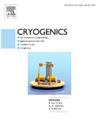低温声发射识别CHN01奥氏体不锈钢断裂阶段
IF 2.1
3区 工程技术
Q3 PHYSICS, APPLIED
引用次数: 0
摘要
本研究采用力学测试和声发射(AE)分析相结合的方法,系统研究了CHN01奥氏体不锈钢在低温(77 K)下的断裂行为。对CHN01固溶热处理试样进行了拉伸和断裂韧性试验,其屈服强度(Rp0.2)为1057 MPa,极限抗拉强度(Rm)为1602 MPa,临时断裂韧性(KQ)为201 MPa·m1/2。同时,使用优化的无监督k-means聚类算法对裂缝测试过程中记录的声发射信号进行分析。识别出两个明显的声发射信号簇,即簇1,具有高频、低能和连续特征,与弹性微裂纹有关;而簇2则表现出低频、高能和爆炸的特征,表明塑性能量耗散。对声发射数据的分析表明,在线弹性变形阶段,91.6%的声发射信号来自聚类1,而在非线性阶段,几乎所有的声发射信号都来自聚类1,表明裂纹扩展过程中释放的能量主要被演化塑性区吸收。这些发现强调了将声发射监测与机械测试相结合的潜力,可以提供对低温下断裂过程的可靠、实时洞察,从而为材料选择、裂纹监测和低温应用(如高场超导磁体)的早期预警提供有价值的指导。本文章由计算机程序翻译,如有差异,请以英文原文为准。
Recognition of fracture stages of CHN01 austenitic stainless steel by acoustic emission at cryogenic temperature
In this study, the fracture behavior of CHN01 austenitic stainless steel at cryogenic temperature (77 K) was systematically investigated using an integrated approach combining mechanical testing and acoustic emission (AE) analysis. Tensile and fracture toughness tests were performed on solid solution heat-treated CHN01 specimens, revealing exceptional mechanical performance with a yield strength (Rp0.2) of 1057 MPa, an ultimate tensile strength (Rm) of 1602 MPa, and a provisional fracture toughness (KQ) of 201 MPa·m1/2. Concurrently, AE signals recorded during fracture testing were analyzed using an optimized unsupervised k-means clustering algorithm. Two distinct AE signal clusters were identified, i.e. cluster 1, characterized by high-frequency, low-energy, and continuous features, which are associated with elastic microcracking; and cluster 2, exhibiting low-frequency, high-energy, and burst characteristics, indicative of plastic energy dissipation. Analysis of the AE data revealed that during the linear elastic deformation phase, 91.6 % of the recorded signals originated from cluster 1, while in the nonlinear phase, almost all AE signals were from cluster 1—suggesting that the energy released during crack propagation was predominantly absorbed by the evolving plastic zone. These findings underscore the potential of integrating AE monitoring with mechanical testing to provide robust, real-time insights into fracture processes at cryogenic temperatures, thereby offering valuable guidance for material selection, crack monitoring, and early warning in cryogenic applications such as high field superconducting magnets.
求助全文
通过发布文献求助,成功后即可免费获取论文全文。
去求助
来源期刊

Cryogenics
物理-热力学
CiteScore
3.80
自引率
9.50%
发文量
0
审稿时长
2.1 months
期刊介绍:
Cryogenics is the world''s leading journal focusing on all aspects of cryoengineering and cryogenics. Papers published in Cryogenics cover a wide variety of subjects in low temperature engineering and research. Among the areas covered are:
- Applications of superconductivity: magnets, electronics, devices
- Superconductors and their properties
- Properties of materials: metals, alloys, composites, polymers, insulations
- New applications of cryogenic technology to processes, devices, machinery
- Refrigeration and liquefaction technology
- Thermodynamics
- Fluid properties and fluid mechanics
- Heat transfer
- Thermometry and measurement science
- Cryogenics in medicine
- Cryoelectronics
 求助内容:
求助内容: 应助结果提醒方式:
应助结果提醒方式:


